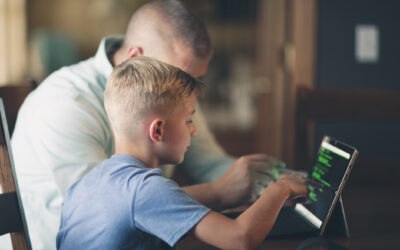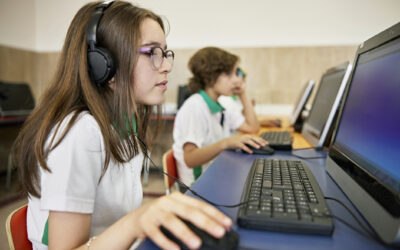Understanding Digital Citizenship
Digital citizenship refers to the responsible use of technology by anyone who uses computers, the internet, and digital devices to engage with society on any level. It’s about understanding the rights, responsibilities, and opportunities that come with digital participation, and using technology in ways that are ethical, respectful, and safe.
For students, becoming responsible digital citizens means learning how to navigate the online world securely and ethically, understanding the implications of their digital footprints, respecting privacy and intellectual property, and developing positive communication skills in digital environments.
Examples of Digital Citizenship & Practice Exercises
“While the exact components of digital citizenship evolve with advances in technology, threats, media, and interconnectivity, the primary goal of digital citizenship stays relatively consistent.”
Taken from: What is Digital Citizenship & What Does It Include?
Below are fundamental skills included in digital citizenship, how it applies to students’ actions and interactions online, and exercises to put these digital citizenship skills into practice.
1. Engaging in Positive Online Behavior
Positive online behavior is the cornerstone of creating a safe and supportive digital environment. It helps in preventing cyberbullying, spreading kindness, and fostering a culture of respect and understanding. Positive interactions enhance the quality of digital communication and build healthy online communities.
Cyberbullying has been a hot topic in 2024, and it’s no wonder why. 64% of American young adults (18-29) have experienced cyberbullying, with middle school-aged cyberbullying victims being statistically almost twice as likely to attempt suicide than non-victims.
In this skill, students should learn to participate in online forums or social media with respect and kindness, following the same social norms and etiquettes they would use in real life, avoiding cyberbullying and reporting any instances of it they encounter.
Activity 1: Role-Playing Different Scenarios Online – Students participate in role-playing activities where they navigate various online interactions, such as commenting on social media posts or responding to messages. The aim is to practice positive communication, empathy, and dealing with negative comments constructively.
Activity 2: Creating a Campaign – Students work in groups to create a digital campaign promoting kindness and respect online. They could use videos, posters, or social media to spread their message, discussing the impact of positive behavior on the digital community.
2. Protecting Personal Information
In an era where data breaches and identity theft are increasingly common, understanding how to protect personal information is essential to students’ safety online. This skill helps prevent students from becoming victims of fraud, protects their privacy and teaches them the value of confidentiality in the digital age.
With this skill, students learn to create strong, unique passwords for their online accounts and are taught the importance of not sharing personal information online. They should also understand the settings on social media that can help protect their information from being publicly accessible.
Activity 1: Password Strength Workshop – Students participate in a workshop to learn about creating strong passwords. They then create their own passwords and explain why they are secure. This can be followed by discussions on the importance of password management tools and how to store passwords securely.
Activity 2: Privacy Settings Exploration – Students are tasked with exploring the privacy settings on a variety of digital platforms (this can be done through guided simulations if direct access is restricted). They present their findings on how to protect personal information on these platforms.
3. Respecting Intellectual Property
Respecting intellectual property fosters creativity, innovation, and fair use of digital materials. It teaches students to value and acknowledge others’ work, leading to more ethical consumption and production of digital content. Understanding copyright laws and licensing also prepares students for future academic and professional endeavors.
When learning this skill, students are taught to cite sources correctly, whether they are using images, text or ideas from the internet. They understand the concept of copyright and the importance of not plagiarizing others’ work.
Activity 1: Copyright Quest – In this activity, students are divided into teams and given a list of online resources. They must determine which ones can be used freely, which require permission, and which ones need to be cited, explaining their reasoning.
Activity 2: Creative Commons Scavenger Hunt – Students participate in a scavenger hunt for images, videos, and texts that are licensed for free use under Creative Commons. They learn how to search for and cite these resources in their projects.
4. Digital Literacy and Critical Thinking
Digital literacy and critical thinking skills are vital in navigating the vast amounts of information available online. They enable students to discern credible sources from misinformation, enhancing their academic research skills and helping them make informed decisions in their personal and digital lives.
In mastering digital literacy skills for digital citizenship, students are trained to evaluate the credibility of online sources and to distinguish between credible news and misinformation. This involves lessons on how to identify reliable websites, check the facts, and cross-reference information.
Activity 1: Fact or Fiction Challenge – Students are given a list of statements or news headlines and must research to determine if they are true or false. They present their findings along with the strategies they used to verify the information.
Activity 2: Creating a Reliable Source Guide – Students work in groups to create a guide on how to identify reliable sources online. The guide could include tips, tricks, and a list of credible websites across various subjects.
5. Contributing to the Digital Community
Contributing positively to digital communities encourages students to use their digital presence for good. Whether through advocacy, raising awareness on important issues or participating in global projects, it empowers students to be active, productive members of the digital society.
In learning this digital citizenship skill, students engage in creating positive digital content, such as blogs, videos, or art that expresses their ideas and opinions in constructive ways. They participate in online communities or projects that aim to make a difference, such as environmental campaigns or social justice initiatives.
Activity 1: Digital Service Projects – Students identify a community issue and use digital tools to address it, such as creating a website, a social media campaign or a digital art project that raises awareness or support.
Activity 2: Participate in Global Classroom Projects – Students join global classroom projects where they collaborate with peers from around the world on a project. This could involve cultural exchanges, environmental campaigns or collaborative research projects.
6. Understanding Digital Footprint and Privacy
Awareness of one’s digital footprint and the implications it has for privacy is crucial in managing online identities. This skill helps students understand how their actions online can affect their future opportunities and relationships and includes educating students about privacy settings and the permanence of online actions, encouraging more mindful digital engagement.
In mastering this skill, students should learn about the concept of a digital footprint and how their actions online can have long-term consequences. They are taught to be mindful of what they share online and to understand the privacy policies of the platforms they use.
Activity 1: Digital Footprint Mapping – Students conduct an audit of their own digital footprint by researching themselves online. They reflect on their findings and create a plan for managing their digital footprint in the future.
Activity 2: Privacy Policy Analysis – In groups, students select a popular online service and analyze its privacy policy. They present a summary of the policy, highlighting any concerns or surprising elements regarding data usage and privacy.
7. Safe Online Interactions
Safe online interactions protect students from potential harm, including cyber predators, scams and inappropriate content. Knowledge of how to interact safely online is essential for their security and well-being, ensuring they can navigate the digital world without falling prey to common dangers.
In learning this skill, students should be educated on the dangers of interacting with strangers online and on how to recognize and avoid potential online scams. They learn the importance of keeping personal conversations and information private and the risks involved in meeting online acquaintances in person without proper precautions.
Activity 1: Scam Identification Workshop – Students participate in a workshop where they learn about common online scams and how to identify them. They then apply this knowledge in a game format, identifying scams from real scenarios.
Activity 2: Creating a Safety Guide for Online Interactions – Students create a guide for safe online interactions, covering topics such as dealing with strangers online, recognizing phishing attempts and the importance of maintaining privacy in online communications.
8. Balancing Screen Time
Balancing screen time is vital for physical and mental health for students. Excessive screen time can lead to issues such as eye strain, sleep disturbances, and reduced physical activity. Encouraging students to balance their digital activities with offline experiences promotes a healthier lifestyle and improves overall well-being.
In this skill, students are encouraged to develop healthy habits around technology use, learning to balance their online activities with offline ones. This includes setting limits on screen time to ensure it does not interfere with sleep, physical activity and real-life interactions.
Activity 1: Screen Time Diary – Students keep a diary of their screen time for a week, noting what activities they are engaging in online. They reflect on their screen time habits and set goals for balancing online and offline activities.
Activity 2: Designing a “Digital Detox” Plan – Students design a “digital detox” plan that includes structured times away from screens, alternative activities to engage in and strategies for disconnecting. They share their plans and discuss the benefits of taking regular breaks from digital devices.
Why Digital Citizenship Matters
Digital citizenship is not just about avoiding harm online; it’s about empowering students to use technology creatively, collaboratively, and effectively. By instilling the principles of digital citizenship in students, educators can help them navigate the complexities of the digital world, making them more informed, respectful and engaged digital citizens.
This education is essential in preparing students not only to face the challenges of the digital age but also to take advantage of its opportunities. Digital citizenship equips students with the skills and knowledge they need to participate fully in society, pursue their interests, and contribute positively to the digital communities they are part of.
Final Thoughts
The concept of digital citizenship is multifaceted, encompassing a range of behaviors and skills that are essential for students in the digital age. By teaching students to be responsible, respectful, and safe online, educators can help them develop into informed and engaged digital citizens. This not only benefits the students in their personal and academic lives but also contributes to a more positive, inclusive and productive digital world for everyone.

Learning.com Team
Staff Writers
Founded in 1999, Learning.com provides educators with solutions to prepare their students with critical digital skills. Our web-based curriculum for grades K-12 engages students as they learn keyboarding, online safety, applied productivity tools, computational thinking, coding and more.
Further Reading
Guide to Teaching Algorithms in Computer Programming for K-12 Students
Algorithms are the heart of computer programming, providing the step-by-step instructions that computers follow to perform tasks and solve problems....
Planning Digital Literacy Assessment: A Simplified Approach
As educators know, assessments are critical to the learning process. They provide beneficial self-checks to students, informative results to...
Technology Skills to Teach Gen Z for Future Success
Gen Z and Gen Alpha will enter a workforce that looks very different than the one their parents and grandparents experienced. Educators know it’s...




